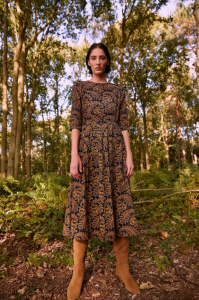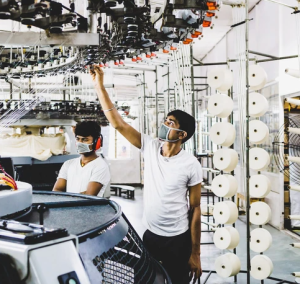
When buying sustainable clothes you are helping protect animals and planet. Along with this it is common to talk about protecting people: not only the people making your clothes, but also you as the wearer of the clothes.
Why is this? Because a plethora of chemicals – many of them rather unpleasant – is used in the production, colouring and finishing of clothes.
Azo dyes are a group of dyes that are often used in the manufacture of clothing. Their advantage is that they are cheap and effective. The huge disadvantage is that they are carcinogenic when they break down. Although these dyes are banned in the EU due to their toxicity, they are still commonly used in fast fashion clothing produced in other parts of the world. Since azo dyes are water-soluble, this makes them easy for your skin to absorb and they can cause skin and eye irritation.
Another example is the chemical formaldehyde, a colorless gas that’s frequently associated with embalming. The chemical helps to keep clothes free of wrinkles, static, or stains, even after multiple washes – which sounds great, but means it stays around for a lot longer.

While inhaling the chemical has been linked to asthma, nausea, and even cancer, wearing clothes with formaldehyde is more commonly associated with dermatitis, as a number of people are allergic to the chemical. Symptoms of dermatitis include rashes, blisters, and itchy, dry skin.
Your skin is your biggest organ and its large surface area means it absorbs things easily – so wearing clothes with chemicals in it can have some pretty nasty negative side-effects. This is unhealthy for us as adults, but even more so for children. In my next blog I will show you some eco and sustainable kids clothing brands: this way you can protect your children from this nasty side-effect of fast fashion.
What else can you do:
- Look for clothing that was plant-dyed or clothing that wasn’t dyed at all, often called “undyed”, “unbleached”, or “natural”.
- Look for GOTS or Oeko-Tex certification on the label, as these organisations prohibit the use of toxic chemicals and dyes in the clothing they certify. Just be sure to check the exact version as the rules may differ.
- Wash your clothing before its first wear to ensure any excess dye is washed off.
- Buy from brands that are sourcing and producing in the EU, since most of the chemicals mentioned are forbidden here.

Bottom line: the most sustainable thing you can do is to reduce what you buy, and re-use, rewear and repair what you have. If that is not possible and you need something new, buy from better brands, like the ones in our Brands section.

